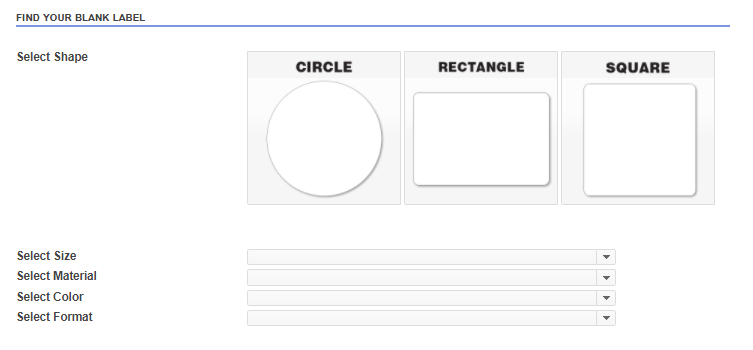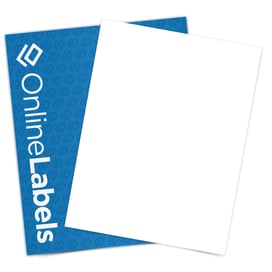Comprehending Just How Blank Labels Work to Enhance Your Labeling Experience
Comprehending the mechanics of blank labels is crucial for enhancing your labeling practices across numerous contexts. These flexible devices provide substantial benefits, such as modification and adaptability, making them a suitable selection for both expert setups and personal use. From supply management to home company, the ramifications of their strategic application can cause boosted efficiency. Nonetheless, to fully understand just how these labels can transform your processes, one need to consider the different types readily available and the myriad ways they can be personalized to fit details needs.

Advantages of Utilizing Blank Labels
Blank labels supply a flexible solution for different labeling requirements, making them important in both individual and expert setups. Their versatility permits users to develop customized labels customized to specific demands, boosting organizational performance. Whether utilized in home workplaces, retail environments, or industrial applications, blank labels promote the identification and classification of items, files, and individual items.
One significant benefit of blank labels is their cost-effectiveness. By permitting customers to print only the labels they need, waste is minimized, and supply monitoring ends up being extra workable. Additionally, blank labels work with different printing techniques, consisting of inkjet and printer, making them accessible for different users.

Moreover, making use of blank labels streamlines the process of upgrading details, as individuals can conveniently print new labels to change outdated ones, making sure that all items and documents are precisely classified. In general, blank labels give a useful and reliable labeling solution for diverse applications.
Kinds of Blank Labels Available
What alternatives are available when it pertains to blank labels? Blank labels can be found in a variety of types, each fit for various applications and choices. The most common types consist of paper labels, which are functional and cost-effective, making them perfect for daily usage. They are readily available in various finishes, such as matte and glossy, enabling visual adaptability.
An additional popular option is synthetic labels, typically made from materials like polyester or vinyl. These labels are understood for their longevity and resistance to water, chemicals, and tearing, making them suitable for harsh environments. They are commonly used in industrial setups or for labeling items that might be revealed to dampness.
In addition, there are thermal transfer labels, which call for a printer that makes use of warmth to move ink onto the tag surface area. These labels are favored for their premium print and durability.
Finally, specialty labels satisfy specific demands, such as detachable why not try here labels for momentary usage or high-temperature labels for extreme problems. Recognizing these choices enables users to select one of the most ideal blank tag for their distinct labeling demands.
Personalization Options for Labels
A broad range of personalization options is readily available for labels, permitting individuals to tailor them to specific demands and branding demands. Users can select from numerous sizes, shapes, and products to guarantee that the labels efficiently fit their intended objective. Typical materials include paper, polyester, and plastic, each using different levels of longevity and visual charm.
Color alternatives play an essential duty in personalization, allowing brand names to preserve uniformity with their business identity. Customers can select from a spectrum of shades or perhaps go with customized printing to match details branding aspects. Additionally, labels can be published with unique layouts, logos, and message, improving brand name acknowledgment and aesthetic influence.
An additional crucial element is the selection of adhesive. Tags can be developed with irreversible, removable, or repositionable adhesives, relying on the application requirements. This versatility permits for effective labeling options throughout various atmospheres, from retail to commercial settings.

Tips for Effective Labeling
Efficient labeling surpasses customization; it also entails critical factors to consider that improve functionality and communication. To achieve effective labeling, start by clearly defining the objective of each tag. Consider the details that requires to be conveyed and guarantee it exists in visit here a simple way. Using succinct language and preventing lingo can dramatically enhance comprehension.
Next, focus on visibility by picking ideal colors and typefaces. High contrast in between text and background boosts readability, while larger typefaces help with fast identification. Furthermore, guarantee that labels are positioned in a consistent and sensible manner, making it less complicated for individuals to find and analyze info.
Take into consideration the sturdiness of labels too. Pick products suited for the certain environment where the labels will be utilized, whether it be inside or outdoors. Waterproof or tear-resistant choices might be essential depending on the context.
Finally, consistently review and update your labels to show any type of adjustments in information or usage. This proactive technique not just keeps quality but also prevents complication gradually. By adhering to these tips, you can optimize the performance of your labeling initiatives, guaranteeing they offer their desired purpose efficiently.
Applications of Blank Labels
Blank labels offer various applications across various industries, making them an indispensable tool for organization and communication. These versatile labels are typically used in storage facilities for inventory management, allowing businesses to conveniently recognize and track items. By using blank labels to storage bins, racks, or pallets, firms can enhance their procedures and minimize the possibility of errors.
In the healthcare sector, blank labels play a vital role in labeling drugs and clinical materials, making sure appropriate identification and use. Adjustable labels can include important information such as dose, expiration dates, and patient information, improving safety and conformity.
In retail, blank labels help in prices products, giving promos, or labeling rack places, which ultimately boosts the client experience. They permit fast updates to prices or product details without the requirement for pre-printed labels.
Moreover, blank labels are advantageous for individual usage, such as organizing office, crafting, or identifying food containers. Their flexibility enables people to produce customized options that meet details requirements. Overall, the applications of blank labels are substantial, underscoring their relevance in promoting performance and clearness in numerous settings.
Verdict
Finally, blank labels offer a flexible and reliable service for numerous identifying demands. Their adaptability in size, form, and material permits customized applications across various environments. By why not find out more leveraging personalization options and efficient labeling approaches, organizations can improve quality and communication (Blank Labels). Eventually, the assimilation of blank labels right into operational processes adds to boosted efficiency, making them an indispensable source for both personal and professional use.
Comments on “Get bulk Blank Labels for cost-effective solutions.”